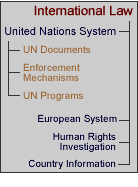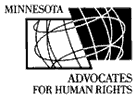|
|
UN Committee on the Rights of the ChildWomen’s advocates may use the Convention on the Rights of the Child to promote the rights of girls to be free from violence. The Committee on the Rights of the Child is the UN body that monitors the Convention on the Rights of the Child. The Committee consists of 10 independent experts, but as of 2003, will be increased to 18 members. One of the Committee’s primary functions is to oversee the progress made by State parties in fulfilling their obligations under the Convention, which is carried out through a reporting/ monitoring process. Currently, there is no mechanism under the Committee for the Rights of the Child to submit individual complaints claiming violations of Convention provisions. States that have [ratified] [link to country pages] the Convention on the Rights of the Child are required to submit periodic reports documenting compliance with the provisions of the treaty every five years. The Committee on the Rights of the Child meets three times a year in regular sessions to review these reports and then will make recommendations to both the national governments and to the UN the General Assembly on compliance with the treaty. Since its creation, the Committee on the Rights of the Child has strongly encouraged non-governmental organizations (NGOs) to become involved in the monitoring process. First, NGOs may participate in pre-sessional working groups of the Committee to provide expert advice on the implementation of the Convention on the Rights of the Child. The Committee invites NGOs to submit “reports, documentation or other information in order to provide it with a comprehensive picture and expertise as to how the Convention is being implemented in a particular country. . . . Information may be submitted by individual NGOs or national coalitions or committees of NGOs.” The Committee provides guidelines on participation in pre-sessional working groups and the procedure for submitting NGO reports, such as when reports should be submitted, the number of copies and when NGOs may be invited to present remarks to the Committee on its website under Guidelines for the participation of partners in pre-sessional working groups. In addition, the Committee has emphasized that NGOs should be allowed to contribute to the State reporting process, while making clear that the obligation to submit a periodic report remains with the national government. Thus, the guidelines to State parties on submitting reports include a series of questions about the extent to which NGOs both participated in the writing of the report and also in the implementation of the Convention. NGO contributions to the State report writing process vary by country, but the Committee has underscored the importance of NGOs maintaining their independence from the government in this process. The Committee also encourages NGOs or coalitions of NGOs to submit entire reports of their own that add to or clarify the State party reports. These “shadow” or alternative country reports provide valuable information to the Committee, but are also moist effective when they adhere to specific guidelines. The website of the Committee on the Rights of the Child includes a Guide for NGO Submissions which outlines a process for submission of reports as well as recommendations. The NGO reporting process is also summarized below. Shadow reports differ from UN complaint mechanisms in that NGOs are
not limited in the number of UN bodies to which they can submit such reports.
Thus, for the purposes of advocacy, NGOs can bring international attention
to issues of violence against women through the monitoring of government obligations
under any treaty that protects women’s human rights. Because the Convention
on the Rights of the Child applies to girls under the age of 18 and explicitly
defines the right to be free from violence, such as physical and sexual abuse
or trafficking, NGOs can use shadow reports as a way to focus attention on
failures to protect women and girls from violence. For example, NGOs from
Poland Ukraine, The World Organization Against Torture (OMCT), an international coalition of NGOs, has also submitted a shadow report to the Moldovan government’s periodic report to the Committee on the Rights of the Child, in which it notes that “women and girls suffer from entrenched gender discrimination which makes them particularly vulnerable to violence in the domestic, community and state spheres.” The reporting mechanism available under the Committee on the Rights of the Child is summarized below. Reporting Mechanism- Committee on the Rights of the Child
Additional ResourcesThe Committee on the Rights of the Child has a webpage with reporting guidelines, the Committee’s concluding observations in past sessions and information about future sessions and general discussions. More information on writing shadow reports, using shadow reports strategically and sample NGO reports can be found in the Human Rights Investigation and Documentation section of this website. The Child Rights Information Network (CRIN) is a global network that disseminates information about children’s rights and the Convention on the Rights of the Child to NGOs, UN agencies, inter-governmental and others. The Child Rights Information Network website contains information and resources that are useful to NGOs. The NGO Group for the Convention on the Rights of the Child also provides support to NGOs in the reporting process under the Convention. The NGO Group for the Convention on the Rights of the Child is a coalition of international NGOs with a specialized body, the Liaison Unit, that supports participation of the NGOs and NGO coalitions in the reporting process to the Committee on the Rights of the Child. The Liaison Unit has created a number of guides for NGOs on submitting alternative reports to the Committee. |
| Home | Contact | Feedback | Disclaimer |

